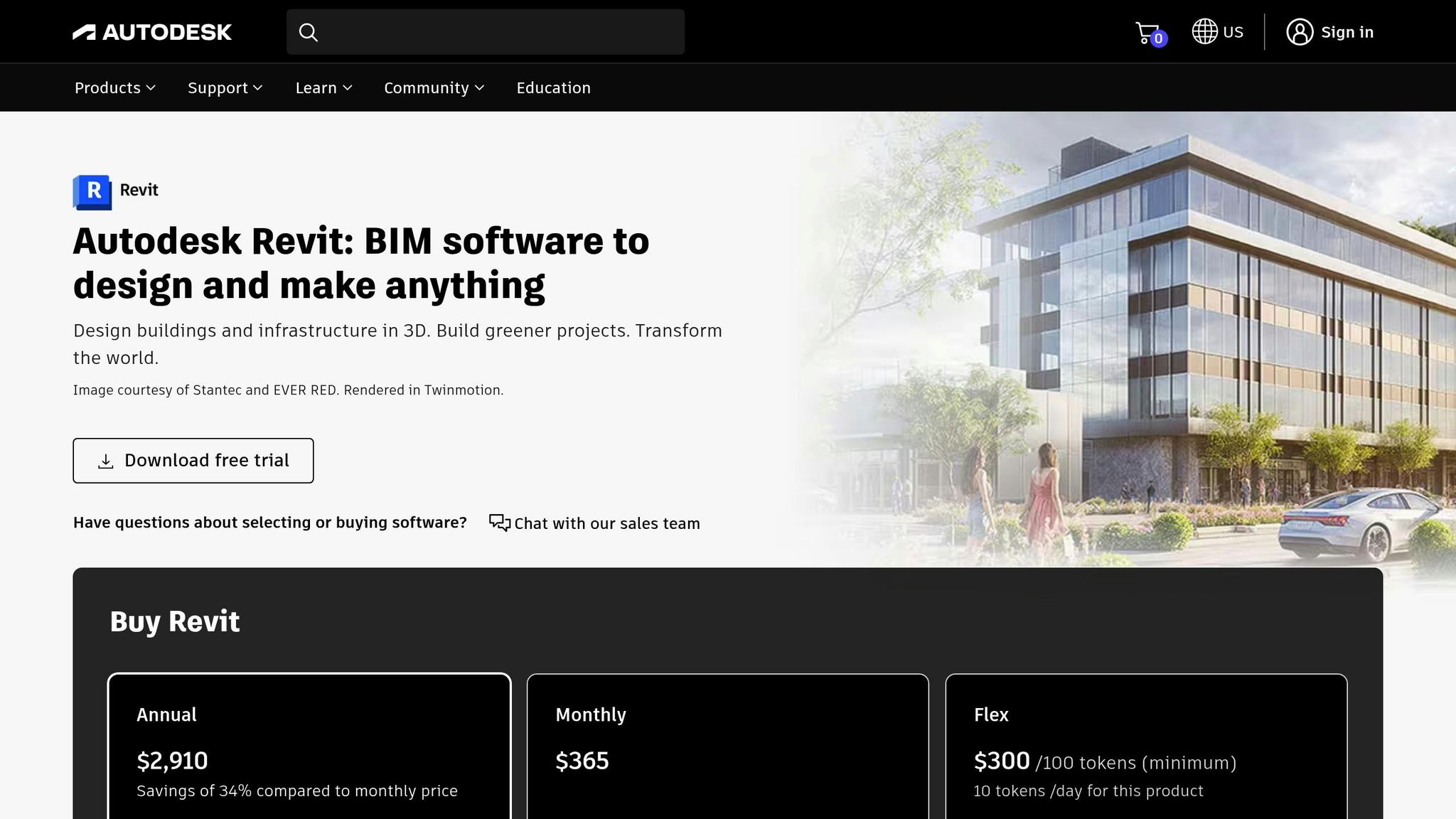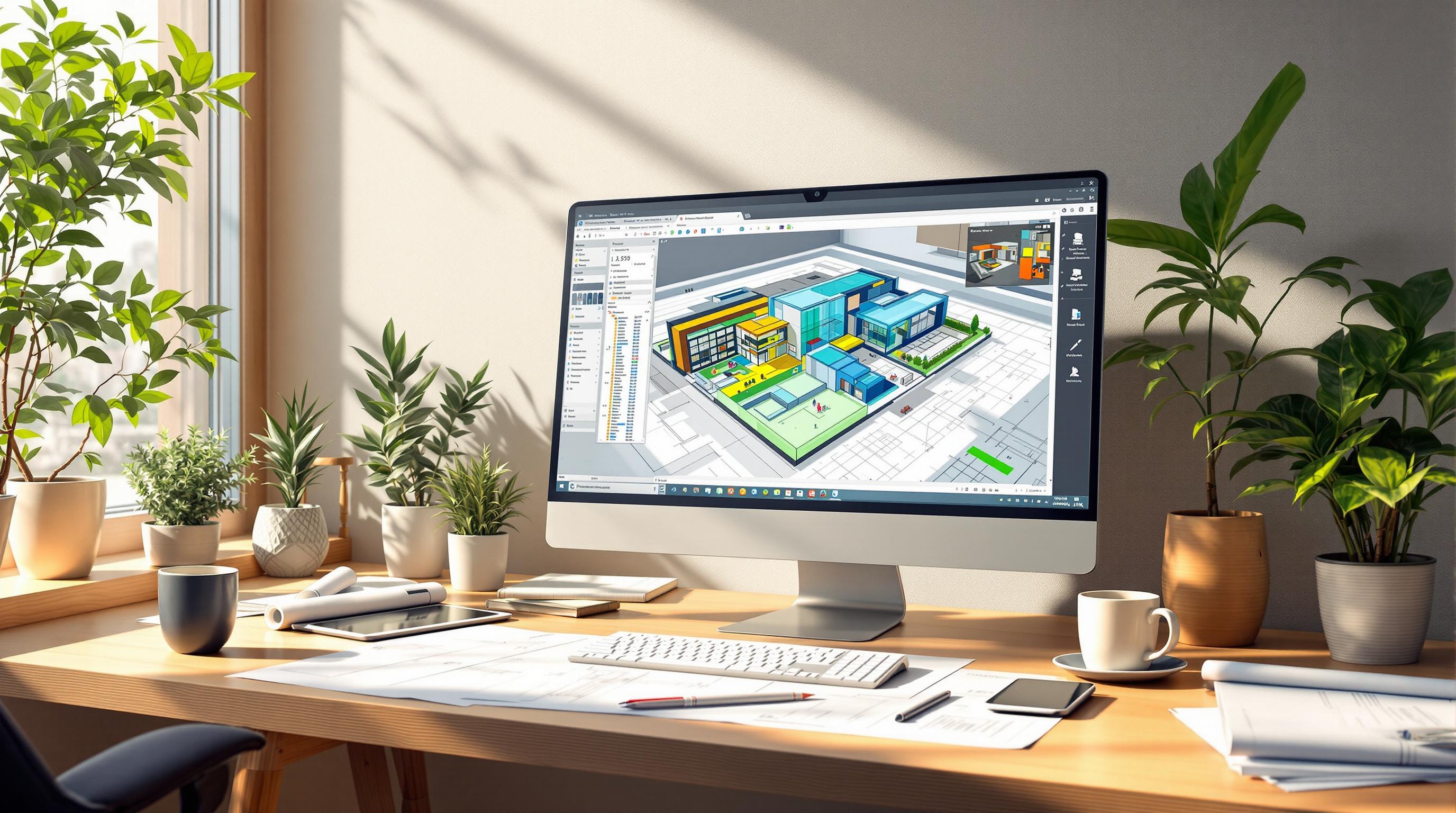Switching from CAD to BIM is no longer optional for AEC startups – it’s essential for staying competitive. BIM centralizes project data, improves collaboration, and reduces costs, making it a game-changer for construction and design workflows. Here’s why and how to transition effectively:
- Why BIM Matters: BIM reduces project costs by up to 10%, speeds up cost estimation by 80%, and cuts unplanned changes by 40%. It’s a smarter, faster way to manage projects.
- Key Differences: Unlike CAD, which focuses on isolated drawings, BIM integrates all project data into a single, dynamic system. This enables real-time collaboration, automatic updates, and better project tracking.
- Challenges to Expect: Data migration, team training, and upfront costs are common barriers. Solutions include cleaning legacy files, phased rollouts, and leadership support.
- 5 Steps to Transition:
- Assess current workflows and set clear goals.
- Choose BIM tools based on cost, scalability, and compatibility.
- Train your team with targeted programs.
- Establish BIM standards for consistency.
- Test with pilot projects and refine processes.
Quick Comparison: CAD vs. BIM
| Feature | CAD Systems | BIM Systems |
|---|---|---|
| Information Flow | Siloed drawings | Centralized data |
| Updates | Manual redrawing | Automatic updates |
| Collaboration | Limited | Real-time |
| Project Tracking | Static documentation | Dynamic models |
BIM offers AEC startups the tools to take on larger, more complex projects while saving time and money. Ready to future-proof your business? Start your transition today.
Webinar: Strategies for a Successful CAD to Revit Transition

Common Barriers When Moving from CAD to BIM
Switching from CAD to BIM comes with its challenges, especially for startups. Let’s break down some of the main hurdles.
Data Transfer and System Issues
Transitioning to BIM often involves technical roadblocks. One major issue is migrating data from older CAD systems. Problems like poor-quality legacy files and mismatched system compatibility can slow everything down.
"The conversion process is not as easy as vendors promise. There are significant complexities that one has to overcome for any migration process to remain successful." – Gaurang Trivedi [2]
A well-known example is Daimler AG‘s switch from Dassault Systemes to Siemens PLM and NX. This process took over five years to complete [2]. While this reflects the scale of large corporations, startups can face similar, albeit smaller-scale, challenges.
Here are some common technical barriers and potential solutions:
| Challenge | Impact | Solution |
|---|---|---|
| Legacy File Quality | Data inaccuracies | Assess and clean up old files |
| System Compatibility | Workflow interruptions | Test for interoperability |
| Data Structure | Loss of information | Use standardized conversion methods |
But technical issues aren’t the only concern – team readiness is just as important.
Team Training and Change Management
For BIM to succeed, teams need proper training and leaders must actively support the shift.
"Change really needs to start from the top-down meaning ownership and/or upper management need to accept, promote and support the changes that are being implemented." – Jason Peckovitch, BIM Manager at Garver [3]
Key steps for effective change management include:
- Leadership Engagement: Get executives on board and ensure they visibly back the transition.
- Skills Development: Offer targeted training sessions led by experienced professionals.
- Cultural Shift: Create an environment open to new technology and workflows.
Once the team is prepared, the next step is to tackle the financial side of the transition.
Budget Planning and Resources
Adopting BIM requires upfront spending on software, hardware, and training. However, these costs are balanced by long-term savings and efficiencies. The risk of sticking with outdated systems can be far greater.
To keep expenses under control, startups should focus on critical features first and consider rolling out BIM in phases. This phased approach helps manage costs while keeping operations steady during the transition.
5 Steps to Switch from CAD to BIM
Step 1: Assess Your Current Setup and Define Goals
Take a close look at your current CAD setup, including workflows, file management, collaboration methods, and project delivery processes. This will give you a clear starting point.
Next, set specific goals for your transition to BIM. These might include:
- Cutting project timelines
- Improving output quality
- Boosting resource efficiency
- Strengthening team collaboration
- Establishing clear client deliverables
With these goals in mind, choose tools that align with your needs.
Step 2: Choose the Right BIM Tools
When selecting BIM tools, consider these factors:
| Factor | Impact | Priority |
|---|---|---|
| Setup Cost | Hardware and software expenses | High |
| Training Needs | Time and resources for learning | High |
| Compatibility | Fit with existing workflows | Medium |
| Scalability | Ability to grow with your needs | Medium |
| Technical Support | Availability of expert help | High |
Step 3: Train Your Team
Once you’ve picked the tools, it’s time to prepare your team.
Design a step-by-step training program that focuses on technical skills and adapting to new workflows. Include essential topics like BIM fundamentals, software usage, and integrating BIM into existing processes.
Step 4: Develop BIM Standards
After training and tool selection, create a standardized system for your BIM processes.
Your BIM standards should include:
| Component | Description | Purpose |
|---|---|---|
| Documentation | Guidelines and requirements | Set clear expectations |
| Content Files | Templates and families | Ensure consistency |
| Support Team | Technical help | Provide ongoing support |
| Training Materials | Learning resources | Build team skills |
| Administration | Oversight and updates | Maintain compliance |
"For the entire system, remember that one change in a subsystem impacts the overall system and often requires another change in a different subsystem." – Autodesk University [4]
Step 5: Test and Refine the BIM Process
Start small by running pilot projects to test your BIM implementation. This will help you:
- Spot and fix bottlenecks
- Adjust your standards
- Refine training programs
- Confirm resource allocation
- Measure performance improvements
Track performance metrics and gather feedback from your team to fine-tune your approach before rolling it out on larger projects.
sbb-itb-51b9a02
Tips for Successful BIM Implementation
Get Team Buy-in Early
For a smooth transition to BIM, it’s crucial to get your entire team on board from the start. Everyone needs to be involved and aligned with the new approach.
"Only once each team member is aligned and onboard, can we really start reaping the benefit of BIM." – Michelle du Plessis, Managing Director and Co-founder at Shft
Here are some ways to ensure your team is fully engaged:
| Strategy | Purpose | Implementation |
|---|---|---|
| Regular Updates | Keep everyone informed | Weekly meetings |
| Feedback Channels | Address concerns early | Suggestion system |
| Success Metrics | Track progress | Monthly reviews |
| Recognition System | Reward adoption efforts | Skill certification |
Once your team is aligned, adopting open BIM standards can help simplify workflows and data-sharing processes.
Use Open BIM Standards
Open BIM standards make it easier to exchange data and collaborate across various platforms. They help create a consistent workflow while leaving room for future scalability.
Key advantages of open BIM standards include:
- Better interoperability between different software tools
- Stronger data accuracy throughout the project lifecycle
- Lower chances of losing information during file transfers
- Future-ready documentation for long-term use
To make the most of your BIM implementation, consider working with experienced professionals.
Work with BIM Experts
Partnering with BIM experts can speed up your implementation process and keep your team informed about the latest developments. Mohamed Nassar, BIM Coordinator, suggests scheduling monthly training sessions to ensure your team stays engaged and up-to-date.
Here’s how experts can help:
| Expert Role | Benefits |
|---|---|
| BIM Consultant | Strategic planning and setup |
| Training Specialist | Tailored skill development |
| Technical Advisor | Ongoing support |
Results of BIM Implementation
Better Team Communication
With cloud-based BIM, project data is centralized, allowing teams to collaborate in real time. Mobile access means team members can review models directly on-site and make quick decisions. This setup helps avoid costly miscommunications and delays.
| Communication Improvement | Impact on Project |
|---|---|
| Real-time Model Sharing | Faster feedback and updates |
| Centralized Data Access | Single, reliable source of information |
| Mobile Site Access | Immediate decision-making on-site |
| Stakeholder Collaboration | Fewer conflicts and misunderstandings |
This streamlined communication makes it easier to tackle more intricate projects.
Handle Larger Projects
BIM doesn’t just improve communication – it also enables startups to take on bigger, more complex projects. By visualizing the entire project before construction begins, potential issues are spotted early, which reduces expensive changes later. BIM also supports automated safety checks, visual risk assessments, greater prefabrication opportunities, and better management of large-scale project data.
Cost and Time Savings
BIM significantly boosts efficiency, cutting both costs and time:
| Metric | Improvement |
|---|---|
| Quote Generation | 80% faster |
| Unbudgeted Changes | 40% fewer |
| Contract Value | Up to 10% savings |
| Overall Time | Up to 7% faster completion |
| Cost Estimation | Accuracy within 3% |
"BIM offers unprecedented benefits in terms of increasing productivity and reducing costs throughout a project’s lifecycle." – Anna Liza Montenegro, Microsol [1]
One case study found that BIM reduced construction time by 50% and costs by 52.36%, thanks to better worker efficiency and shorter project timelines [6]. McKinsey research backs this up, showing that 75% of companies using BIM see positive returns. These benefits stem from accurate early-stage cost estimation, smarter material purchasing, better project sequencing, fewer errors, and improved scheduling.
These gains make BIM an essential tool for AEC startups looking to grow and succeed.
Conclusion: BIM as a Growth Tool for AEC Startups
Switching from CAD to BIM gives AEC startups a strong advantage for growth. BIM’s ability to simulate projects before construction has changed how startups address complex construction issues [5]. This virtual-first method allows teams to catch and fix potential problems early, cutting down on expensive rework and delays.
By combining BIM with advanced delivery methods like IPD or Design-Build, startups can see even greater benefits. These methods encourage profit-sharing and real collaboration among stakeholders [7]. BIM helps streamline processes – like managing change orders and schedules – while offering real-time project updates.
| Growth Area | Impact of BIM |
|---|---|
| Managing Complexity | Handles intricate designs (airports, hospitals, labs) |
| Reducing Risks | Standardizes workflows and captures successful practices |
| Financial Oversight | Tracks progress and costs in real time |
| Competitive Edge | Addresses rising demand for BIM skills |
The improvements in communication and cost management directly support scalable growth. Fully integrating BIM into daily operations allows startups to handle more advanced projects efficiently.









Leave a Reply